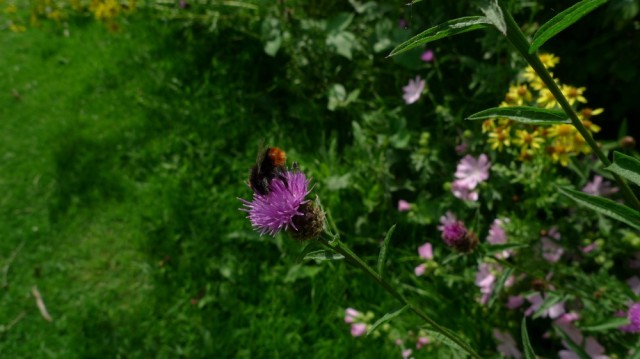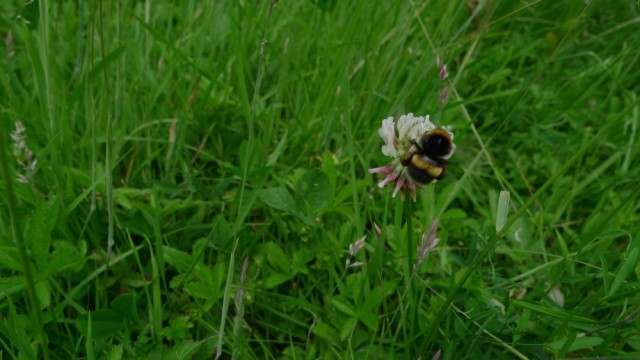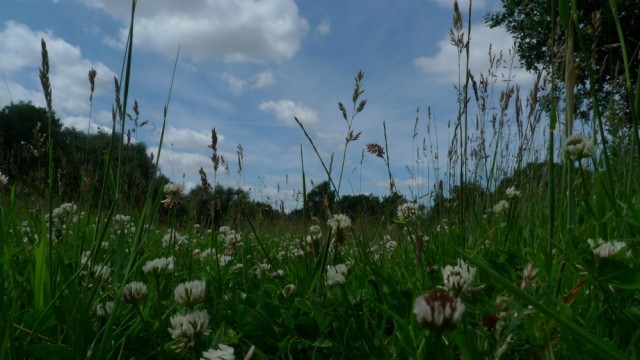I bought this new book by Dave Goulson, founder of the Bumblebee Conservation Trust, after hearing him speak at the ‘Future without bees‘ talk at the Southbank Centre. And it’s brilliant: entertaining, an insight into a life spent investigating nature and an education in all things bumblebee.
Amelia at A French Garden has already done a proper review of this fantastic book, so instead I thought I’d do a quick list of seven things I learnt from it:
1) Bumblebee workers in a particular species can vary in size dramatically (p.157-163).We only ever see the bigger foragers with large eyes and bigger brains out and about – there are smaller workers who spend most of their time hidden away in the nest rearing young. This is somewhat like ant castes and a different way of doing things to honey bees (worker honey bees are all the same size and graduate to more complex tasks as they get older).
2) Bumblebees are better suited to colder climates (p.31-34). Their furry coats help them keep heat in, and the contractions of their flight muscles – bumbles flap their wings 200 times per second – generates a lot of heat. This heat can be difficult to get rid of if the surrounding air temperature is high; if their body temperature exceeds 44°C they will die. For this reason, on very hot days in summer (like we’re having now in England) bumbles will tend to have a rest around midday and begin foraging again in the early evening as the air cools down. Dave once had a buff-tailed bumblebee colony that survived a night in the freezer at -30°C, the workers gathered over the brood, the queen in their centre.

3) The European commercial trade in bumblebees for pollination probably requires around 500 metric tonnes of pollen each year to rear the bumblebees (p.180-181). This pollen is bought in from honey-beekeepers all over Europe and is almost inevitably contaminated with a range of bee diseases. After the bumblebees consume the pollen they are despatched all over the world, very possibly spreading diseases to honey bees, other bumble bees or native bee species.
4) In the wild, some bumblebee species seem to get nearly all their pollen from legumes such as clovers, trefoils, vetches, peas and beans. Not all pollen is equal – legume pollen is especially rich in protein and essential amino acids which bees cannot manufacture themselves.
5) The UK bumblebee species struggling the most are particularly fond of clover, particularly red clover and other wild legumes such as tufted vetch and bird’s foot trefoil, that produce this protein-rich pollen (p.209-211). These plants also have deep flowers, requiring the long tongues that most of our rare bumblebee species possess – such as the great yellow, short-haired and ruderal bumbles. The rare species tend to be meadow specialists, favouring the legumes that grow in meadows and the deep meadow flowers. No wonder they are struggling – we hardly have any meadows left.
6) Dumbledore is an old English word for bumblebee, possibly originating in Somerset or Sussex (p.214). Cute.
7) Badgers are particularly fond of eating bumblebee nests in dry summers when worms have burrowed too deep for them to find (p.96). The bumblebee nests can be located by smell. Dave says “You can create a similar odour by pouring black treacle and sherry over a pair of dirty running socks, sealing them into a Tupperware box and then leaving it in a warm place for a month.”
Finally, a lovely quote from Dave, p.208:
“I began studying bumblebees not because they are important pollinators but because they are fascinating, because they behave in interesting and mysterious ways, and because they are rather lovable. But as I became more familiar with what was known about them, it was made clear that they were in urgent need of help.”

I always say this, but it’s particularly relevant for this book of all books – if you choose to buy it or indeed any other items from Amazon, please consider going through the Bumblebee Conservation Trust’s Fundraising page. Each time you access Amazon.co.uk via their link and make a purchase this brilliant charity receives a donation worth 8% of your total purchase, at no extra cost to you.
See also: ‘A brief history of how bees sexed up earth and gave flowers their colors‘, a grand review of the book by writer Maria Popova.





Have not seen any bumblebees here for a good while . . . we finally have the bees swarming over all over the salvia flowers, but they are almost done (the flowers, not the bees), and my shrubs are not flowering yet (russian sage and bluebeard).
LikeLike
I like the names of your shrubs, very romantic sounding. The bumbles were slow to appear in England this year but now I’m seeing them everywhere.
LikeLike
I’ve not seen any bumbles on vetch, but the honeybees sure like it. I was able to capture some very close up video of bees pollinating some yellow vetch (I think that’s what it is) and when reviewing the video on the lap top, I was surprised that, well…it was so ‘racy.’
I guess we are lucky to have all the bumbles, but then it doesn’t usually get more than 25 deg. C
After reading about the badgers, I’m so glad we don’t have them around here.
“Dumbledore?” Interesting. 🙂
LikeLike
Your bee videos are awesome. I’d actually love to have badgers around, but they are large, shy animals so not suited to London. Foxes dig up their nests too.
LikeLike
I’m glad you enjoyed the book too. It is packed full of such interesting stuff. They must always have been well loved as Dumbledore sounds a very affectionate name.
LikeLike
Yes! Wonder if that was the inspiration for JK Rowling’s Professor Dumbledore.
LikeLike
Thanks for this Emily, I must get a copy!
LikeLike
It’s a great read and you will learn loads about bumbles for sure 🙂
LikeLike
Bumbles are very lovable especially the really fuzzy ones.
LikeLike
Yes – they look so huggable. I could watch them for hours.
LikeLike
Thanks for that Emily, this is definitely a ‘must buy’ book. Looking forward to reading it.
LikeLike
Hope you enjoy it as much as I did!
LikeLike
We have plenty of bumblebees here. Maybe because we have so many Echinacea, Garden Phlox and Borage, and yes, we let the clover grow. We feel guilty every time we have to mow the lawn. Seems like we’re shorting the bees.
LikeLike
Fantastic, good to know the bumbles are thriving around you.
LikeLike
Emily, am I right that in this hot weather, it’s good to leave some water in a shallow dish for the bees? My sister puts twigs in a birdbath so that if they go for an unexpected swim they have something to climb onto… RH
LikeLike
Yes indeed, and other wildlife will appreciate it too. I have been leaving out a dish with pebbles in so the bees have something to sit on and don’t drown. The birdbath is a good idea as the water will smell more and they’ll locate it more easily. Clean water from the tap doesn’t have so much of a smell and they seem to prefer ‘stinkier’ water sources. Some beekeepers put lemongrass oil in the water to attract them, but not everyone has that sitting round the house!
LikeLike
How interesting! There was recently an article in the Seattle Times about how a bumblebee that was once thought extinct was found again in a park nearby. It hadn’t been seen in something like 30 years, but a photographer managed to take some blurry pictures of it. Its got a fuzzy white behind, and the picture he took was of a queen.
I’ve been doing what I can in my garden to encourage pollinators. My neighbors and family aren’t too excited about the clover in the front (Someone even left a sticky-note on the front door saying they would mow our lawn for $25) but its always covered in honeybees and bumblebees, so I’m leaving it alone. Plus, the soil is literally dust in my garden, and that clover is helping to greatly improve the lawn. It’s so bad in places that the ground has dried up and begun cracking. It looks like that even in the winter.
LikeLike
Fantastic stuff. You are saving the bees, which is more than your neighbours can say. Clover can make its own nitrogen fertiliser, so is ideal for poor soils. I find it really pretty too.
LikeLike
Yeah, my mom makes fun of me because of how much I talk about nitrogen fixing plants haha. We have terrible soil, so i’m trying to integrate plants that change that.
Plus, when you get enough clover together it smells good too. I don’t understand why everyone has a fit if its in your yard.
LikeLike
How fascinating! Sounds like a marvelous book.
“You can create a similar odour by pouring black treacle and sherry over a pair of dirty running socks, sealing them into a Tupperware box and then leaving it in a warm place for a month.”
It’s not only me that does that then?
Wonder what he does with the socks at the end of the month? Uses them to attract badgers presumably – but the badgers will get cross when they realise there are no bumblebee nests to be had.
LikeLike
Perhaps the badgers could eat the socks and get tipsy from the sherry.
LikeLike
Bumblebees…Will only sting if their nest is threatened or if you squeeze them, sit on them or stand on them. They are not naturally aggressive and it takes a lot to provoke them. If they feel threatened by you they will ‘tell’ you. They do this by raising one of their middle legs in the air. If you back off they will put their leg back down – but if you go closer (and if they are unhappy about this) they will lift another leg in the air. If you go closer still – they will turn on their back and show you their sting! This is called ‘posturing’ but very rarely leads to them actually stinging you. If they DO ever sting, their sting has no barb like the honeybee, so they will not die afterwards :)Male bumblebees do not have a sting. You can identify the males of some species quite easily by their yellow facial hair and little yellow moustaches. Also, male bumblebees are in less hurry than the females when foraging and have thin hairy legs (females have a wide shiny, smooth top corbicula on their back legs and are often carrying pollen)I often stroke the bumblebees (male and female) in my garden, or pick them up from pavements and roads to put them in safer places and none of these bees have ever stung me.
LikeLike
That’s very useful to know, thanks Leona! Will try to remember about the leg motions and the little yellow moustaches. Lovely that you rescue the bees, I try to do that too.
LikeLike
Pingback: London Honey Show 2014: part 1, Dave Goulson | Adventuresinbeeland's Blog
Pingback: Where The Wild Things Were. | Beating The Bounds